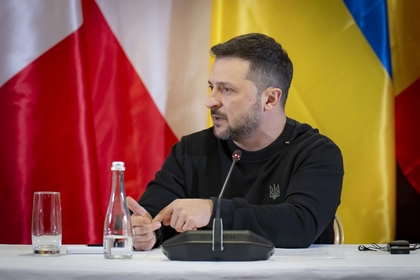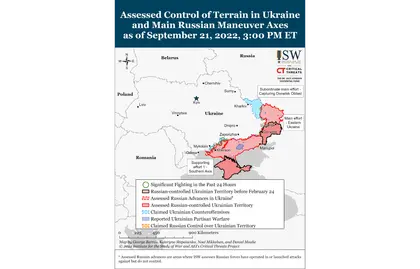Key Takeaways
- Russian President Vladimir Putin’s announced “partial mobilization” will not materially affect the course of the war in the coming months.
- Putin did not explicitly threaten to use nuclear weapons if Ukraine continues counter-offensive operations to liberate occupied areas after Russian annexation.
- Ukrainian forces likely continued offensive operations around Lyman.
- Ukrainian forces conducted strikes north and east of Kherson City as part of an operational-level interdiction campaign against Russian logistics, military, and transportation assets in Kherson Oblast.
- Ukrainian and Russian sources identified three areas of kinetic activity on September 21: northwest of Kherson City, near the Ukrainian bridgehead over the Inhulets River, and south of the Kherson-Dnipropetrovsk Oblast border around Vysokopillya.
- Russian federal subjects (regions) are continuing crypto-mobilization efforts regardless of Russian President Vladimir Putin’s declaration of partial mobilization.
- Russian-appointed occupation administrators are likely increasing law enforcement and filtration measures in occupied areas of Ukraine in preparation for Russia’s sham annexation referenda.
Russian President Vladimir Putin’s announcement of “partial mobilization” on September 21 reflected many problems Russia faces in its faltering invasion of Ukraine that Moscow is unlikely to be able to resolve in the coming months.[1] Putin’s order to mobilize part of Russia’s “trained” reserve, that is, individuals who have completed their mandatory conscript service, will not generate significant usable Russian combat power for months. It may suffice to sustain the current levels of Russian military manpower in 2023 by offsetting Russian casualties, although even that is not yet clear. It will occur in deliberate phases, Russian Defense Minister Sergei Shoigu said in an interview on September 21, likely precluding any sudden influx of Russian forces that could dramatically shift the tide of the war.[2] Russia’s partial mobilization will thus not deprive Ukraine of the opportunity to liberate more of its occupied territory into and through the winter.
JOIN US ON TELEGRAM
Follow our coverage of the war on the @Kyivpost_official.
Putin and Shoigu emphatically said that only reservists who have completed their initial military service will be mobilized, making clear that Russia will not be expanding conscription. Shoigu also declared that students will not be affected and told them to go about their studies without concern.[3] These comments were clearly intended to allay fears among the Russian population that “partial mobilization” was code for general conscription.

Zelensky Criticizes G20’s Weak Position on Russian Invasion
It is not clear how much of the Russian reserve has already been deployed to fight in Ukraine. Western intelligence officials reportedly said in November 2021 that Russia had called up “tens of thousands of reservists” as part of its pre-war mobilization.[4] Ukrainian military officials reported in June 2022 that Russian forces had committed 80,000 members of the mobilized reserve to fight in Ukraine.[5] The Russian military likely called up the most combat-ready reserves in that pre-war mobilization effort, which suggests that the current partial mobilization will begin by drawing on less combat-ready personnel from the outset.
Russian reserves are poorly trained to begin with and receive no refresher training once their conscription period is completed. Russian mandatory military service is only one year, which gives conscripts little time to learn how to be soldiers, to begin with. The absence of refresher training after that initial period accelerates the degradation of learned soldier skills over time. Shoigu referred to the intent of calling up reservists with “combat experience,” but very few Russian reservists other than those now serving in Ukraine have any combat experience.[6]
Reports conflict regarding how much training reservists called up in the partial mobilization will receive. Shoigu described a deliberate training process that would familiarize or re-familiarize mobilized reservists with crew, team, detachment, and then platoon-level operations before deploying them to fight. That process should take weeks, if not months, to bring reservists from civilian life to war readiness. Federation Council Committee on Defense and Security head Viktor Bondarev reportedly said that mobilized reservists would train for over a month before being deployed.[7] A military commissariat in Kursk Oblast, on the other hand, reportedly announced that reservists under 30 would deploy immediately with no additional training.[8]
Putin emphatically did not say that the Russian nuclear umbrella would cover annexed areas of Ukraine nor did he tie mobilization to the annexation. He addressed partial mobilization, annexation referenda in Russian-occupied areas of Ukraine, and the possibility of nuclear war in his speech—but as separate topics rather than a coherent whole. The fact that he mentioned all three topics in a single speech was clearly meant to suggest a linkage, but he went out of his way to avoid making any such linkage explicit.
Putin framed his comments about the possibility of Russian nuclear weapons use in the context of supposed Western threats to use nuclear weapons against Russia. He claimed that Western officials were talking about “the possibility and permissibility of using weapons of mass destruction—nuclear weapons—against Russia.” He continued, “I wish to remind those who allow themselves such statements about Russia that our country also has various means of attack…” His comment on this topic concludes by noting that Russia would use all means at its disposal in response to a threat to “the territorial integrity of our country, for the defense of Russia and our people.” That comment could be interpreted as applying in advance to the soon-to-be annexed areas of occupied Ukraine, but its placement in the speech and context do not by any means make such an interpretation obvious. Nor is Putin’s language in making this comment different from formal Kremlin policy or from previous statements by Russian officials. Putin’s speech should not be read as an explicit threat that Russia would use nuclear weapons against Ukraine if Ukraine continues counter-offensives against occupied territories after annexation.
Putin did not connect annexation with the partial mobilization either, defending the need for partial mobilization by referring to the length of the lines along which Russian forces are now fighting and Western assistance to Ukraine. He noted that the front lines now stretch for more than a thousand kilometers to explain why more Russian forces are needed. He and Shoigu also heavily emphasized the false narrative that Russia is fighting not Ukraine but NATO and the West. This narrative is not new. It is not even markedly different from the initial false justifications Putin offered before ordering the invasion in February.[9] The formal Kremlin position has long been that NATO was pushing Ukraine to war with Russia, that NATO was preparing to give Ukraine nuclear weapons, and that NATO forces were taking up or preparing to take up positions in Ukraine. Putin’s and Shoigu’s repetitions of that line do not reflect an escalation in their rhetoric.
Russia’s partial mobilization will not transform the war this year and may or may not have a significant impact on Russia’s ability to continue operations at their current level next year. Ukraine and the West should neither dismiss it nor exaggerate it.
Authors: Karolina Hird, Kateryna Stepanenko, Grace Mappes, Mason Clark, Kat Lawlor, and Frederick W. Kagan
See the full report here.
You can also highlight the text and press Ctrl + Enter






